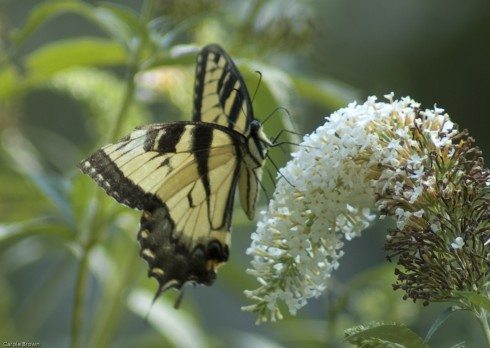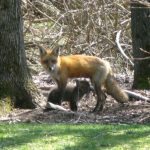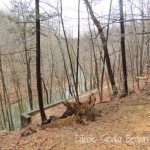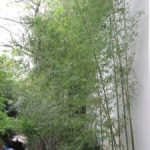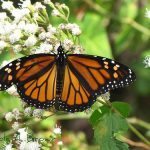Invasive Buddleia (Butterfly Bush)
I’m sure you’ve all read books about butterfly gardening, and almost every one of them recommends Butterfly Bush (Budleia spp). But did you know that Butterfly Bush is a highly invasive plant and is destroying native butterfly and wildlife habitat?
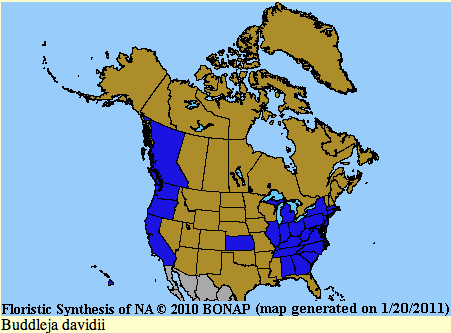
States Where Butterfly Bush is Invasive
This is a plant from Asia, and now it’s spreading out of control along stream banks and other areas all over the country. How long do you really think we have until Butterfly Bush is listed as invasive in Wisconsin? Or Iowa? Or any of these other states in the middle of this map?
Why take a chance when there are so many better choices in native plants that butterflies will flock to that are much healthier for butterflies and also for our fragile ecosystems?
Each Butterfly Bush produces over 100,000 seeds, and they are distributed in the wind, so even though you may not see seedlings popping up in your garden, your Butterfly Bush is probably responsible for spreading devastation in natural areas like stream banks and disturbed industrial sites. You don’t want to be the one responsible for this damage to our ecosystems do you?
Irresponsible Conservation Organizations
It’s sad and shameful that organizations dedicated to the protection of butterflies, especially the Monarch, are spreading information that is ultimately harmful to our wild areas when there are so many better alternatives.
Even though they may be dedicated to doing good for a particular species and had a lot of success in reaching out to the general public and raising awareness about declining species and how we can help them, it’s really not helpful in the longterm if that supposed “help” is destroying the habitats that all other wildlife is dependent on for their very survival.
For example, MonarchWatch.org has butterfly bush at the top of their recommended planting list, with no disclaimer that it’s listed as an invasive plant in over 20 states and counting, and also no instruction that if you’ve got this problematic plant in your garden, you MUST deadhead it before it produces the abundant seeds that are wreaking such havoc.
In reality, how many home gardeners are actually going to spend the time to remove every one of the multitude of flower heads every week or so? Not many, sadly.
No matter how much we want to help the Monarchs and all the other butterflies, native bees, and other wildlife, it is very irresponsible of these organizations to continue to promote a plant that causes so much damage, and not educate their supporters about the many, many better native alternatives to the invasive Butterfly Bush.
If the goal really is to save Monarchs (but why single out just one species when so many other butterflies are in trouble?), why would we do something that can be so harmful? Why wouldn’t we work to save, restore, or create more habitat for ALL butterflies?
We can all do so much better. And organizations and educators have a duty and a responsibility to give their supporters the best information that doesn’t cause more problems down the road.
It is my most sincere wish that MonarchWatch and other similar conservation organizations would be very careful and much more thoughtful about the plants they recommend. The MonarchWatch recommended nectar planting list is kind of a sad and useless joke with no scientific names, no disclaimers about Butterfly Bush, and no specifics about regional differences. It’s not really helpful at all because the best nectar plants for butterflies will depend completely on where you live. Each region of the country is very different, and there are many native plants that will work well in one ecotype and not in others.
It would be so much more helpful if the good folks at MonarchWatch took some time to update this page. My suggestion is that they model their plant recommendations after the excellent resources at The Pollinator Partnership. You simply enter your zip code and you’re directed to one of the 31 ecotype-specific Pollinator Friendly Planting Guides, and in there you’ll find a calendar of native plants appropriate for your region so that you can have year round value to butterflies and other wildlife.
I would happily become a big fan and supporter of this otherwise worthy organization if this were to happen.
Even my favorite butterfly organization, the North American Butterfly Association (NABA) has contributed to this confusion, which makes me very sad. They devoted their entire Summer 2012 issue of Butterfly Gardener to “The Great Butterfly Bush Debate,” which showcased the two opposing sides about Butterfly Bush.
One article was written by Mary Anne Borge, a New Jersey naturalist:
It’s not that Butterflybush is inherently a bad plant. It is native to China, not North America, Europe or New Zealand. The insects, birds and other residents with which it evolved in China and that depend on it for food there aren’t present in the areas in which it was introduced. So there are no species here that will naturally keep it in check. This is always a potential danger when a species is introduced in an environment in which it is not native, where its food web partners are missing.
The other side was written by Lenora Larson, a Kansas Master Gardener:
Now the Butterfly Bush is under attack from well-meaning native plant lovers…Native Plant Absolutists gnash their teeth in frustration, but butterflies are not ideologues If their foot’s chemical receptor and the molecule match, the plant’s origin is irrelevant. Why be so rigid? Our Regional Director of the Kansas Native Plant Society has a greenhouse and raises hundreds of butterfly bushes to sell at area Master Gardener plant sales. My sense of justice is offended by Americans who eat predominantly non-native foods, but would refuse that same pleasure to butterflies.
What accounts for these opposing views? Mary Anne lives in New Jersey, where Butterfly Bush is running rampant along stream banks and other natural areas and is a huge problem and concern for environmentalists.
Lenora lives in Kansas, where Butterfly Bush has not yet become invasive, so it’s no big deal to her, but she at least makes an appropriate disclaimer:
Gardeners in at-risk states do not need to deny butterflies their favorite adult beverage. Buddleja spreads by seed, so if the flowers are deadheaded just as they start to wither, there will be no volunteers. Do you have the resolve and discipline? If not, look for another plant choice. If you can commit to religious deadheading, the butterflies and many other pollinators will thank you.
We have to remember that for folks living in the interior and southern states Butterfly Bush is not (yet) classified as invasive in those states (but we know that it’s probably only a matter of time), so they don’t understand what all the fuss is about. I’d love to see the organizations that continue to promote it at the very least do it with a disclaimer about potential problems. I’d be even more thrilled if they would start recommending native plants as more beneficial alternatives
The thing is, people really want to help butterflies. We all know the Monarch butterfly population is well below normal this year, and this is a big concern to all of us. But in trying to do good, are we really making other problems with our beleaguered natural areas worse?
I have worked for almost 30 years teaching people to garden sustainably, conserve natural resources and create welcoming habitat for wildlife in their gardens so that they will attract more birds, butterflies, native bees, and other wildlife to their gardens. But educating the educators may now need to become my primary mission.
Dr. Thomas Barnes of Kentucky Native Plants has a great article dispelling the myths and misinformation about the invasive nature of Butterfly Bush.
In Why You Shouldn’t Plant Butterfly Bush, Debbie Hadley talks about the many harmful impacts this plant is having on our environment.
Conservation organizations have a duty and responsibility to give the best information to their audiences. Many home gardeners have no idea that butterfly bush (the Buddleia species) is invasive. And they also are not aware that there are MUCH better native alternatives to the invasive butterfly bush.
So it is irresponsible of butterfly experts to not educate people and give them the tools and information that would help these home gardeners make much more beneficial choices for butterflies and the environment.
Our experts have made many mistakes over the years, at some points recommending the planting of multiflora rose, crown vetch, russian olive, and so many other plants that, despite their best intentions, have gotten out of control and are now costing millions of dollars every year to try to control. Hopefully we can learn from our mistakes in recommending invasive plants.
Butterflies PREFER the native plants
Yes, butterflies DO come to nectar and butterfly bush, but this plant is not a larval host plant for ANY butterfly species. You’re getting just one ecosystem service for a few weeks every year, when if you planted native alternatives to the invasive butterfly bush, you’d be providing a wide variety of ecosystem services in all seasons of the year.
If a wildlife garden has a wide variety of native plants you’ll begin to discover that the butterflies actually prefer the natives and won’t even bother going to the butterfly bush.
So forget about wasting your time trying to deadhead your butterfly bush at this time of year, and instead plant some of these native plants. Your butterflies will thank you!
If you are trying to attract more butterflies to your garden, the first thing you need to understand is that more butterfly bushes do not mean more butterflies. Yes, butterflies do feed on the nectar of butterfly bushes but that’s where the attraction ends.
The real key to having more butterflies in your garden is to find out which of the more than 700 species of butterflies in North America are common to your region. Once you know which butterflies are likely to visit your garden, you can start making of a list of appropriate plants to entice them into making your garden their home. ~Debbie Roberts in Butterfly Bushes Do Not Mean More Butterflies
Native Alternatives to Invasive Butterfly Bush
Joe Pye (Eupatorium spp)
42 species of butterflies and moths will use Joe Pye as larval host plant in addition to providing abundant nectar for butterflies, native bees, and other pollinators
Goldenrod (Solidago spp)
135 species of butterflies and moths use
Goldenrod as a larval host plant, and many species of insects also use parts of this plant for shelter and food. Go to Cape May during the peak of Monarch migration, and you won’t find many Monarchs on any butterfly bushes, they are all over the Seaside Goldenrod.
Aster (Symphyotrichum)
112 species of butterflies and moths use the Asters as larval host plants, in addition to providing abundant nectar. New England Aster is gorgeous planted alongside your Goldenrod, and you’ll spend many happy hours watching all the pollinators who come to visit.
The Top 10 Native Perennials for Butterflies
For more native plants that support a lot of butterflies at all stages of their lives see:
IdahoCycling.com – Idaho Cycling Enthusiasts
GolfSW.com – Golf Southwest Courses & Golf Tips
ArkansasHeritageTrails.com – Guide to Historic Arkansas Trails
Post a Comment Below!
More From Ecosystem Gardening:
Submit your review | |
It's September 9 2022. The monarchs are here everyday. So are many insects. The attraction is the Butterfly shrub. Black Knight. The butterflies get their sucrose rich nectar, then move over the brown stems of the echinacea where they grab hold of the strong stems, open their wings, and rest. Then it's off to the next plant in the rain garden a few feet away. The swamp milkweed where they lay their eggs, and then fly off into my property somewhere. They do this every single day. They have diversity in a small rain garden that include native grasses, Montauk daisy, salvias, Nigellas, zinnias, black-eyed susans, cosmos, Lobelias, Asclepius tuberoses, white alyssum, pink cone flower, swamp milkweed, blazing star, Russian sage, and more. The September insects and birds love it. Goldfinches and sparrows are eating the cone flower seeds every day. There's often water in the rain garden. It's quite beautiful. Thanks to Lenora Larson who wrote: " Now the Butterfly Bush is under attack from well-meaning native plant lovers…Native Plant Absolutists gnash their teeth in frustration, but butterflies are not ideologues If their foot’s chemical receptor and the molecule match, the plant’s origin is irrelevant. Why be so rigid? Our Regional Director of the Kansas Native Plant Society has a greenhouse and raises hundreds of butterfly bushes to sell at area Master Gardener plant sales. My sense of justice is offended by Americans who eat predominantly non-native foods, but would refuse that same pleasure to butterflies."
Linda McParland, Master Gardener since 1987. New York
Count me in also as someone who has grown Butterfly Bush for a long time and has not found it invasive. I'm all in favor of native plants in the garden, and they make up 75% of my own garden, but Butterfly Bush is too effective at attracting pollinators to dismiss, just based on misinformation that's become viral. Introduced and Invasive are NOT synonyms. I have a redbud tree in my yard, which is native, yet is producing seedlings all over my and my neighbors' yards. Some say Butterfly Bush should not be planted because native larvae to not feed on them. Well, many species of butterflies feeding on your flowers lay eggs on trees and shrubs, which their larvae feed on. Monarchs are one of the few species for which both larvae and adults depend on the same plant. Diversity in both plant species and bloom period is what matters, and Butterfly Bush has a place in that strategy.
I have lived with a butterfly bush for many years and it provides our land with a plethora of pollinators. There is a creek below us and a pasture across the street. In 8 years it has not spread to either,and if it had Im sure it would have been appreciated by the neighbors. Our farm began to flourish after we planted that butterfly bush. Our roses finally took and our vegetables are abundant!
"Invasive" is a word usually used to describe a species of plant or animal that has been introduced to an area formerly foreign to it where it now thrives. The introduction is sometimes at the hands of humans, but natute has been finding succesdful habitats to spread its expressions of life around using other forms of nature such as wind, flowing water, and even as hitchikers on fur and feathers, since way before humanity entered the picture. "The only constant in the Universe is change" bears contemplating. Humams are, aftet all, just another part of nature and just like bees which sometimes carry pollen of one species to another thereby creating hybreds, humans play a role in the lamdscaping of the planet, too. We're not above making "oops" choices (even nature would seem to do that from our limited human perceptions), but the butterfly bush is not likely to be the cause of extinction of anything.
This blog post should be removed. It highlights your lack of gardening knowledge. Especially at a time when butterflies and bees are in short supply. The bulk of pollution comes from massive manufacturing plants trying to keep up with the ever growing demands of consumerism. Not from seeds blowing in the wind.
A shameful article to put it mildly.
As with many plants, the level of invasiveness of butterfly bush likely depends on the zone. I live in upstate NY where butterfly bushes are not entirely hardy and die back severely in winter. Since they may not survive here unless covered, they are not a common plant here and are extremely unlikely to self seed. My one butterfly bush draws more humming birds than butterflies, who seem to prefer swamp milkweed and verbena bonariensis.
I live in Lancaster County PA and I can assure you that butterfly bush does spread very readily, I have found it on the side of the road, where you go to get on the highway, trust me no one planted that butterfly bush there. I've seen it growing in mass along a hiking trail that crosses a couple of towns, right next to another highly invasive, tree of heaven.
Did some of you even read the article? Just because pollinators flock to your plant doesn't mean it is the best nectar source for them. I have a huge swamp milkweed that not only looks beautiful, but all summer long was full of monarch butterflies, (actually a male monarch kind of took charge over it and chased off a couple of eastern black swallotails off), I have two huge white boneset filled to the brim with all kinds of pollinators, tons of skippers, and sulphur butterflies. blue Mistflower also very popular, I found a monarch butterfly delighting in it recently.
Why offer the open bar with no hotel or restaurant to feed its customer and just trap them there to die? Sure you may have other native plants. But the side of the road in the middle of the highway (where someone else's butterfly bush seeded to) is not going to have any other host plants around it (they don't I saw plenty of garlic mustard next to that butterfly bush, which I pulled) so the butterfly and bees will come stay there for the nutritionally deficient nectar, when instead the monarch could be nectaring and laying eggs on its own host plant.
You think you are planting for them, but you are not. You are planting for yourself and the aesthetic of your garden.
Clearly the author has some sort of beef with someone MonarchWatch. I have 3 gorgeous non-spreading BB bushes and all butterflies love them, not just Monarchs- so I'm not sure what the author is talking about when they say "Why wouldn’t we work to save, restore, or create more habitat for ALL butterflies?".
Really strange article.
Ive had butterfly bushes for over 22 and they are not invasive. Ive never seen another butterfly bush that wasnt specifically panted. Mine have never spread… i wish they would. The seeds arent light enough to spread more than a yard or two. So i have personal experience that says this article is BS
From experience I must agree 100% with this article. I live in Scotland and in the past 20 years I’ve seen our area go from almost no Butterfly Bushes to them taking over. Every vacant lot is covered in them and we’ve got one trying to grow on our roof! I’d say you might not be seeing them taking over now but just wait.
The two authorities quoted are from different states: New Jersey vs. Kansas. This is cited as explaining their diametrically opposed opinions. The supposition is that New Jersey is "where Butterfly Bush is running rampant" while "Butterfly Bush has not yet become invasive" in Kansas. However, anyone familiar with the Midwest will quickly notice that Kansas IS identified on the illustration as being one of the states overrun by the subject bush.
I live in central PA and I have never seen a butterfly bush in the wild, and I get around a fair bit. Anyone who's ever tried to grow it from seed knows it almost never succeeds unlike butterfly weed (which is milkweed so I doubt the native-plant folks have an issue with it) and it's kind of a fraud for seed companies to even sell it! Frankly if it thrives in disturbed industrial sites I don't see a big problem, but I sure am not seeing it along stream beds or really anywhere else.
Why in earth would you suggest goldenrod as a replacement for a butterfly bush? Goldenrod is weed in most places.
I live in western Michigan, 100 yards from Lake Michigan in a migration flight path. My yard is full of pollinator friendly plants, including three butterfly bushes that I planted, and a number that are a result of self-seeding. I have been very consistent in removing spent blossoms, but there always seem to be escapee seeds that sprout in the spring in seemingly inhospitable locations like the very edge of a driveway or between beach rocks in a path. I hate to throw away plants, so I have transplanted a few of these renegades, and they always survive with minimal attention. A single milkweed pod thrown into the middle of my perennial somewhat undisciplined garden several years ago has now resulted in a plethora of milkweed and an increasing population of milkweed loving larvae! This article is a reminder that I need to keep some control of what I have sown!
Working as a professional gardener for Somerset County, as well as hiking around the state of NJ and surrounding areas, I can't say I've ever seen butterfly bush in the wild. I've never even seen them spreading into the woods near our butterfly bush bed which has been there for decades. Obviously this may not be the same for everywhere in the US, and it's better to err on the side of caution, but my coworkers and I have discussed buddleia as an invasive and we all seem to thing that it doesn't seem to be invasive in central NJ at least.
I have had one dwarf butterfly bush flowering for the past 3-4 years. It attracts lots of bees and butterflies, but I have not seen any other butterfly bushes in my garden. I wish it would multiply - it attracts so many butterflies and bees! I live in NC.
All I can submit to this question is, I live in N. C. There are bees, wasps, all kinds of butterflies,hummingbirds, everyday at my 2 butterfly bushes. Which have not multiplied anywhere on my property or down my road. Not invasive at all here. They die back every year to the ground. They are also a little late bloomer. They are a great addition to my garden and a benefit to the insects and birds. I will NOT remove mine. Very sad about your opinion.
While most butterfly bushes commercially available are from China, and there are lesser known non invasive varieties from Chile, Arizona and Texas desserts. There are also now some very new varieties that don’t seed.

